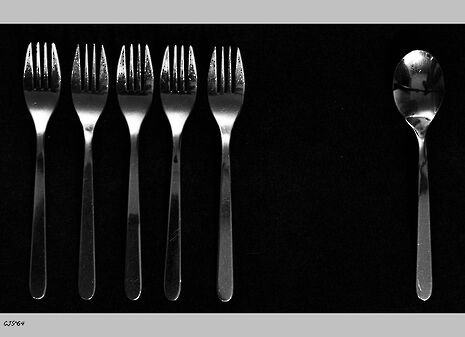Formal education: how to save the Queen and tell your truffles from terrine
Fearing your first formal? Anna Hollingsworth brings to you a crash course in fine dining, Cambridge-style

You might’ve spent your school years swanning about at fancy dinners, maybe an academic gown is your idea of trackies, and maybe duck paté canapés are your Dorritos, but that definitely wasn’t the case for me. And unless all the university access schemes have gone awry big time, it won’t be the case for most of this year’s fresher intake either. This guide is your 1.01 to formals, from nailing matriculation dinner to telling your truffles from terrine.
Cutlery and crockery – a crash course
You’ve said your bon appétits, and everyone in your immediate vicinity (the people to your left, right, and across the table) have been served – that’s when you’re good to go – but you’re faced with more cutlery than you’ll probably ever see in your gyp. All you need to navigate the jungle of silverware is a rule of the thumb or two. With knives and forks, start from the outside, working your way closer to the plate as the courses are served. Unless, of course, you have a soup dish, in which case you go for the spoon – not meaning to be patronizing or anything – before continuing with the knife and fork project. As for telling which bread and which array of glasses is yours, form a circle with your thumb and index finger on both hands. Your left hand will form a lower case ‘b’ and your right a ‘d’ – which translates into bread on your left, and drink on your right. A trick that is sure to impress your baffled co-diners (and a reference to Varsity wouldn’t go amiss either!)
Speaking in tongues and drinking from horns
If your college is one of the older ones and doesn’t pride itself in being progressive by doing away with hierarchical power structures like high table, you’ll most likely be subjected to standing up when the fellows enter and leave the hall, or when they read out grace. I can’t say I’ve ever wholly mastered all the finesse of moves and responses, so I’ve spent much of my formal life (and to be honest, a lot of my life outside hall as well) just doing what others do and mumbling what others mumble, and so far it’s worked out pretty well. The same goes for any obscure traditions that you may come across: at Corpus, certain dinners involve passing an ancient cup made from an aurochs’ horn (a cow-like mammal extinct since the 17th century) and having a swig of mystery liquid after a complicated bowing routine. Trust the expert, and just fake it till you make it.
“One friend of mine was subjected to her DoS testing his new set of interview questions on her, while another had to endure a vintage fellow vocally hating everything from Ireland to women.”
Mastering the nodding
If you’re anything like me and would rather choose food over friends, the compulsory social bit can be a bit of a bane when attending dinners where a seating plan separates you from your buddies – hello matriculation. And if you’re the only person doing your subject in your college – hello linguistics – you’ll have the added fun of sitting with subject the college thinks are vaguely related to yours – hello MMLers, English students, and, yes, even Medics. Worry not, though, at matriculation dinner everyone will be equally new to Cambridge, and you can bond over generic things like the freebies you got from Freshers’ Fair or guessing what’s on your plate (see below).
As for the fellows and other college staples dotted among you, many of them do dinners as their job and will happily chat away with very little input from you. Nodding takes you a long way, especially when you can’t hear what the person across the table is saying or you’re awkwardly left out from all the conversations taking place around you (I spent matriculation dinner watching a student and fellow become best friends over the three courses and head over to the pub after). There’s nothing like strategically timed nodding to make you look like you’re engaging – a great skill to harness for supervisions as well.
That said, you might be graced with the presence of some of the, ahm, more eccentric fellows. One friend of mine was subjected to her DoS testing his new set of interview questions on her, while another had to endure a vintage fellow vocally hating everything from Ireland to women. What can I say? Both are still alive, and equipped with anecdotes for future generations, if not a pleasant dinner experience.
What are you wearing?
Expect frantic questions of ‘what are you wearing’ (most of the time not in the kinky sense) before your first formal. That depends on your college (they can vary from anything-but-sportswear to formal-dress-with-gowns). For most of the special occasion dinners – matriculation, graduation, you know the drill – a suit (or smart jacket and trousers) won’t go amiss; if you’re opting for a dress, there’s no need for full length nor massive frills. A classic black dress is my trusty companion, and has never gone wrong, surviving everything from candle wax, to slashing my back when crawling under a table at a boat club dinner. As people progress through their degrees, there formal dress will get progressively more casual: you can tell the keen fresher from the dissertation-swamped finalist by their levels of formality.
For those at gown-enforcing colleges and especially those with slippier gown styles: yes, it can get tricky. For a while, I considered sewing Velcro on mine for extra grip, but in the end, I’ve just learnt to embrace the off-the-shoulder look. Just check the hem doesn’t get caught under your chair leg to avoid any face-in-your-dessert moments.
“For a while, I considered sewing Velcro on mine for extra grip, but in the end, I’ve just learnt to embrace the off-the-shoulder look.”
Playing the culinary bingo
During my formal time, I’ve been plated everything from pitta, garlic bread, bread roll and lasagne all at one particularly carb-laden Caius dinner, to poached figs in port at John’s and an enigmatic trio of citrus shavings at Corpus. Most of the time, I don’t know what I’m getting, though, thanks to the chefs’ propensity to showcase their linguistic skills on the menu in the form of a lovely mélange of English and a type of French that escapes even French speakers. Condés au fromage, anyone? Or perhaps some Camargue risotto, with a dash of endive marmalade? At least the game of guess-what-you’re-getting works as a fool-proof icebreaker.
Save the Queen!
Pennying is essentially the fine art of sticking a one pence piece into someone’s glass, who’ll then have to down the contents thereof, and save the Queen from drowning. Alternatively, you can stick a five pence coin into someone’s dessert and watch them eat it without using their hands. If you’re a DIY type, go for the engineer’s penny, twisting the coin so that it fits into a wine bottle, and have fun witnessing your friend subject themselves to alcohol poisoning downing the bottle.
If, like me, you’d rather be the predator than prey, you’ll soon master the skill of keeping your food safe (my bacteriophobia helps me here: a coin sticky with who knows what, oh yum). One hand on your wine glass keeps your drink safe, according to the rules, as does sticking a piece of cutlery into your dessert.
I can’t say trying to finish a raspberry mousse served in a wine glass with no hands was my finest but at least I lived to tell the tale and developed some fine tongue action skills on the side.
I wouldn’t want to spoil all the formal fun for you, I’ll leave you to discover the extra fineties of dining in style: how to secure the best bread roll (poppy seed)?
How to smuggle mead instead of wine into hall? Is three courses really enough (quite often, no) and do you really need a trip to Sainsbury’s for their finest on-offer cookies afterwards (very often, yes)? Sit back, relax, and enjoy
 Comment / Plastic pubs: the problem with Cambridge alehouses 5 January 2026
Comment / Plastic pubs: the problem with Cambridge alehouses 5 January 2026 News / Cambridge academics stand out in King’s 2026 Honours List2 January 2026
News / Cambridge academics stand out in King’s 2026 Honours List2 January 2026 News / Cambridge businesses concerned infrastructure delays will hurt growth5 January 2026
News / Cambridge businesses concerned infrastructure delays will hurt growth5 January 2026 News / AstraZeneca sues for £32 million over faulty construction at Cambridge Campus31 December 2025
News / AstraZeneca sues for £32 million over faulty construction at Cambridge Campus31 December 2025 Interviews / You don’t need to peak at Cambridge, says Robin Harding31 December 2025
Interviews / You don’t need to peak at Cambridge, says Robin Harding31 December 2025









